Thread란?
- Process
- 실행중인 프로그램
- OS로부터 메모리를 할당받음 - Thread
- 실제 프로그램이 수행되는 작업의 최소단위
- 하나의 프로세스는 하나이상의 Thread를 가지게 됨

Thread 구현하기
- 자바 Thread 클래스로부터 상속받아 구현

- Runnable 인터페이스 구현
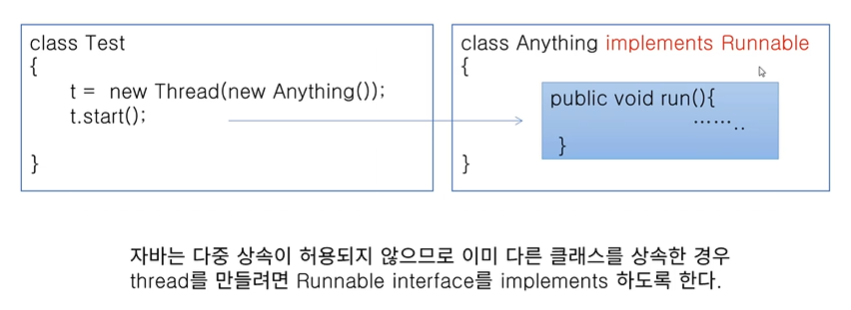
class MyThread implements Runnable{
// 방법2. implements Runnable하는 법
@Override
public void run() {
int i;
for(i=0;i<=200;i++) {
System.out.print(i+"\t");
try {
Thread.sleep(10);
} catch (InterruptedException e) {
e.printStackTrace();
}
}
}
// 방법1. extends Thread하는 법
// public void run() {
// int i;
// for(i=0;i<=200;i++) {
// System.out.print(i+"\t");
// try {
// sleep(10);
// } catch (InterruptedException e) {
// e.printStackTrace();
// }
// }
// }
}
public class ThreadTest {
public static void main(String[] args) {
//스레드는 총 3개로 메인스레드 start,end먼저 실행하고 첫번째스레드,두번째스레드 실행함
System.out.println("start");
// MyThread th1=new MyThread();
// MyThread th2=new MyThread();
// th1.start();
// th2.start();
MyThread runner1=new MyThread();
Thread th1=new Thread(runner1);
th1.start();
MyThread runner2=new MyThread();
Thread th2=new Thread(runner2);
th2.start();
System.out.println("end");
}
}Multi-thread 프로그래밍
- 동시에 여러 개의 Thread가 수행되는 프로그래밍
- Thread는 각각의 작업공간(context)를 가짐
- 공유 자원이 있는 경우 race condition이 발생
- critical section에 대한 동기화(synchronization)의 구현이 필요
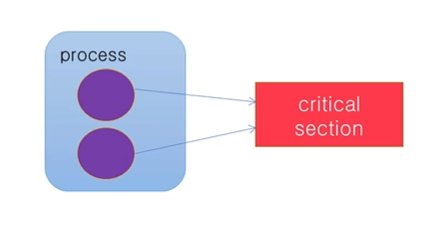
Thread의 여러가지 메서드 활용
- Runnable한 상태가 아니면 cpu를 점유할 수 없음
- thread가 cpu를 점유할 수 없게 된 상태를 Not Runnable이라고 함
- (sleep,wait,join)세가지의 메서드에 의해 Not Runnable 상태로 빠지게 됨
- 다시 Runnable상태로 돌아오려면 sleep은 시간이 지나면 돌아오고, wait은 notify나 notifyall메서드가 호출이 되면 돌아오고, join은 다른스레드가 끝나게 되면 돌아옴
- 다시 Runnable상태로 못돌아오고 좀비상태로 된 thread는 interrupt 인셉션을 날리면 예외처리되서 나오게됨
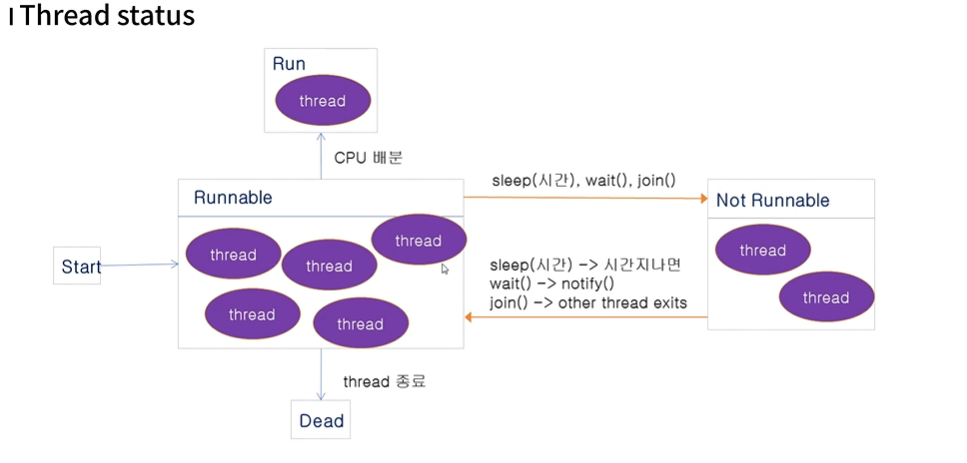
Thread 우선순위
- 그냥 실행하게 되면 NORMAL_PRIORITY 5를 가지게 됨

join() 메서드
- 다른 Thread의 결과를 보고 진행해야 하는 일이 있는 경우 join() 메서드를 활용
- join() 메서드를 호출한 thread가 non-runnable상태가 됨

public class JoinTest extends Thread{
int start;
int end;
int total;
public JoinTest(int start, int end) {
this.start=start;
this.end=end;
}
public void run() {
int i;
for(i=start;i<=end;i++) {
total += i;
}
}
public static void main(String[] args) {
JoinTest jt1=new JoinTest(1, 50);
JoinTest jt2=new JoinTest(51, 100);
jt1.start();
jt2.start();
try {
jt1.join();
jt2.join();
} catch (InterruptedException e) {
e.printStackTrace();
}
int total=jt1.total+jt2.total;
System.out.println("jt1.total = "+ jt1.total);
System.out.println("jt2.total = "+ jt2.total);
System.out.println(total);
}
}interrupt() 메서드
- 다른 thread에 예외를 발생시키는 interrupt를 보냄
- thread가 join(),sleep(),wait() 메서드에 의해 블럭킹 되었다면 interrupt에 의해 다시 runnable상태가 될 수 있음
public class InterruptTest extends Thread{
public void run() {
int i;
for(i=0;i<100;i++) {
System.out.println(i);
}
try {
sleep(5000);
} catch (InterruptedException e) {
System.out.println(e);
System.out.println("Wake!!!");
}
}
public static void main(String[] args) {
InterruptTest test= new InterruptTest();
test.start();
test.interrupt();
System.out.println("end");
}
}Thread 종료하기
- 데몬 등 무한 반복하는 thread가 종료될 수 있도록 run() 메서드 내의 while문을 활용
- Thread.stop()은 사용하지 않음
public class TerminateThread extends Thread{
private boolean flag=false;
int i;
public TerminateThread(String name) {
super(name);
}
public void run() {
while(!flag) {
try {
sleep(100);
} catch (InterruptedException e) {
// TODO Auto-generated catch block
e.printStackTrace();
}
}
System.out.println(getName()+"end");
}
public void setFlag(boolean flag) {
this.flag=flag;
}
public static void main(String[] args) throws IOException {
TerminateThread threadA=new TerminateThread("A");
TerminateThread threadB=new TerminateThread("B");
threadA.start();
threadB.start();
int in;
while(true) {
in=System.in.read();
if(in == 'A') {
threadA.setFlag(true);
}
else if(in == 'B') {
threadB.setFlag(true);
}else if( in == 'M') {
threadA.setFlag(true);
threadB.setFlag(true);
break;
}
// else {
// System.out.println("try again");
// }
}
System.out.println("main end");
}
}임계 영역 (critical section)
- 두 개 이상의 thread가 동시에 접근하게 되는 리소스
- critical section과 동시에 thread가 접근하게 되면 실행결과를 보장할 수 없음
- thread간의 순서를 맞추는 동기화(synchronization)이 필요
동기화 (synchronization)
- 임계 영역에 여러 thread가 접근하는 경우 한 thread가 수행하는 동안 공유 자원을 lock하려 다른 thread의 접근을 막음
- 동기화를 잘못 구현하면 deadlock에 빠질 수 있음
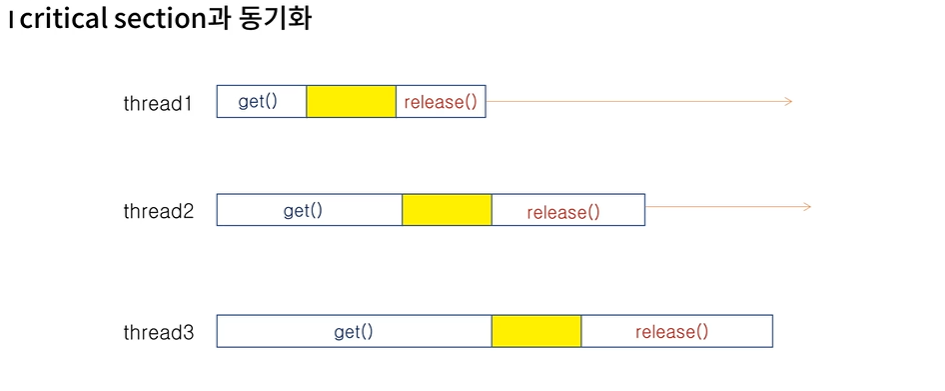
자바에서 동기화 구현
- synchronized 수행문과 synchronized 메서드를 이용
- synchronized 수행문
synchronized(참조형 수식){ }
참조형 수식에 해당되는 객체에 lock을 건다 - synchronized 메서드
- 현재 이 메서드가 속해 있는 객체에 lock을 건다.
- synchronized 메서드 내에서 다른 synchronized 메서드를 호출하지 않는다.(deadlock 방지위해)
방식1. synchronized 메서드방식
class Bank{
private int money=10000;
//saveMoney가 수행되는 동안 다른쓰레드가 Bank에 접근못하게함
//Park이 실행되는 동안 ParkWife는 접근못함
public synchronized void saveMoney(int save) {
int m=this.getMoney();
try {
Thread.sleep(3000);
}catch(InterruptedException e){
e.printStackTrace();
}
setMoney(m+save);
}
public synchronized void minusMoney(int minus) {
int m=this.getMoney();
try {
Thread.sleep(200);
}catch(InterruptedException e){
e.printStackTrace();
}
setMoney(m-minus);
}
public int getMoney() {
return money;
}
public void setMoney(int money) {
this.money = money;
}
}
class Park extends Thread{
public void run() {
System.out.println("start save");
SyncTest.myBank.saveMoney(3000);
System.out.println("start money : "+ SyncTest.myBank.getMoney());
}
}
class ParkWife extends Thread{
public void run() {
System.out.println("start minus");
SyncTest.myBank.minusMoney(1000);
System.out.println("start money : "+ SyncTest.myBank.getMoney());
}
}
public class SyncTest {
public static Bank myBank= new Bank();
public static void main(String[] args) throws InterruptedException {
Park p= new Park();
p.start();
Thread.sleep(200);
ParkWife pw=new ParkWife();
pw.start();
}
}방식2. synchronized 블럭방식
class Bank{
private int money=10000;
//saveMoney가 수행되는 동안 다른쓰레드가 Bank에 접근못하게함
//Park이 실행되는 동안 ParkWife는 접근못함
public synchronized void saveMoney(int save) {
synchronized (this) {
int m=this.getMoney();
try {
Thread.sleep(3000);
}catch(InterruptedException e){
e.printStackTrace();
}
setMoney(m+save);
}
}
//생략- 만약에 쓰레드안에 동기화를 적용시키고 싶다면 run()에 synchronized를 주면 안되고 run메소드안에 synchronized를 블럭화시키면된다.
class Bank{
private int money=10000;
//saveMoney가 수행되는 동안 다른쓰레드가 Bank에 접근못하게함
//Park이 실행되는 동안 ParkWife는 접근못함
public void saveMoney(int save) {
int m=this.getMoney();
try {
Thread.sleep(3000);
}catch(InterruptedException e){
e.printStackTrace();
}
setMoney(m+save);
}
public void minusMoney(int minus) {
int m=this.getMoney();
try {
Thread.sleep(200);
}catch(InterruptedException e){
e.printStackTrace();
}
setMoney(m-minus);
}
public int getMoney() {
return money;
}
public void setMoney(int money) {
this.money = money;
}
}
class Park extends Thread{
public void run() {
synchronized (SyncTest.myBank) {
System.out.println("start save");
SyncTest.myBank.saveMoney(3000);
System.out.println("start money : "+ SyncTest.myBank.getMoney());
}
}
}
class ParkWife extends Thread{
public void run() {
synchronized (SyncTest.myBank) {
System.out.println("start minus");
SyncTest.myBank.minusMoney(1000);
System.out.println("start money : "+ SyncTest.myBank.getMoney());
}
}
}
public class SyncTest {
public static Bank myBank= new Bank();
public static void main(String[] args) throws InterruptedException {
Park p= new Park();
p.start();
Thread.sleep(200);
ParkWife pw=new ParkWife();
pw.start();
}
}deadlock
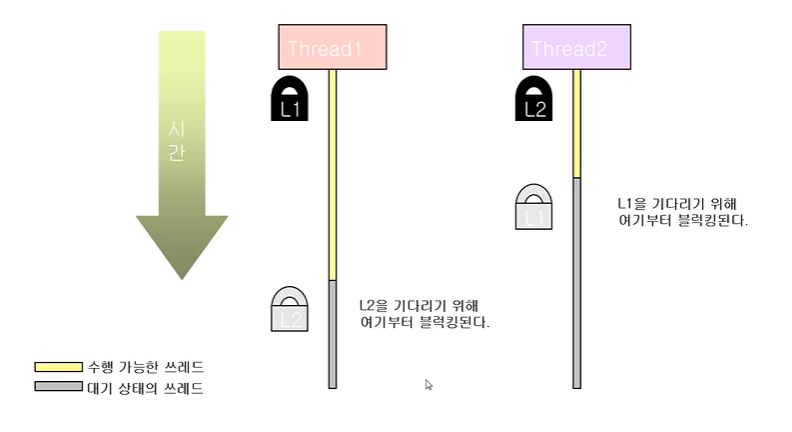
wait()/notify()
- wait() : 리소스가 더이상 유효하지 않은 경우 리소스가 사용 가능할 때까지 위해 thread를 non-runnable상태로 전환, wait()상태가 된 thread은 notify()가 호출 될때까지 기다린다.
- notify() : wait()하고 있는 thread 중 한 thread를 runnable한 상태로 깨움
- notifyAll()
- wait()하고 있는 모든 thread가 runnable한 상태가 되도록 함
- notify()보다 notifyAll()을 사용하기를 권장
- 특정 thread가 통지를 받도록 제어 할 수 없으므로 모두 깨운 후 scheduler에 CPU를 점유하는 것이 좀 더 공평하다고 함
class FastLibrary{
public ArrayList<String> books=new ArrayList<String>();
public FastLibrary() {
books.add("태백산맥 1");
books.add("태백산맥 2");
books.add("태백산맥 3");
}
public synchronized String lendBook() throws InterruptedException {
Thread t=Thread.currentThread();
//책이 없으면 못빌리는 것으로 if문 null처리
//if(books.size() == 0) return null;
if(books.size() ==0) {
System.out.println(t.getName() + "wating start");
wait();
System.out.println(t.getName() + "wating end");
}
String title=books.remove(0);
System.out.println(t.getName()+ ":" + title + " lend");
return title;
}
public synchronized void returnBook(String title) {
Thread t=Thread.currentThread();
books.add(title);
notify();
System.out.println(t.getName()+ ":" + title + " return");
}
}
class Student extends Thread{
public void run() {
try {
String title=LibraryMain.library.lendBook();
if ( title == null) return;
sleep(5000);
LibraryMain.library.returnBook(title);
} catch (InterruptedException e) {
// TODO Auto-generated catch block
e.printStackTrace();
}
}
}
public class LibraryMain {
public static FastLibrary library=new FastLibrary();
public static void main(String[] args) {
Student std1=new Student();
Student std2=new Student();
Student std3=new Student();
Student std4=new Student();
Student std5=new Student();
Student std6=new Student();
std1.start();
std2.start();
std3.start();
std4.start();
std5.start();
std6.start();
}
}